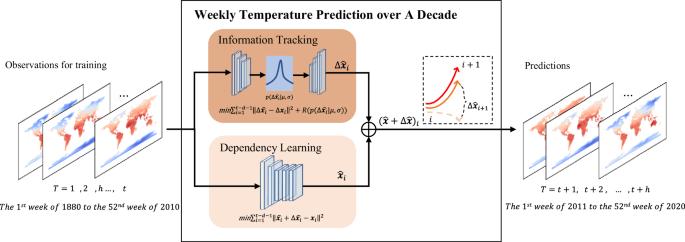连续一周的陆地表面温度模型预测结果在十年内保持不变,并有混沌行为跟踪
IF 8.1
1区 地球科学
Q1 ENVIRONMENTAL SCIENCES
引用次数: 0
摘要
几十年的气温预测为量化未来气候变化的预期影响提供了重要信息。然而,由于气温变化的混沌性质,这种预测极具挑战性。在此,我们设计了一种涉及信息跟踪机制的预测方法,旨在通过根据当前预测提供下一步预测误差的概率反馈,在预测阶段跟踪和适应温度动态变化。我们将这种可视为模型校准器的信息跟踪机制整合到所提方法的目标函数中,以获得避免误差累积所需的修正。对十年内全球每周陆地表面温度预测任务的实验结果验证了所提方法的有效性。使用信息跟踪机制对每周气温变化预测进行概率反馈,以校准数值天气预报模式,有助于避免十年误差累积。本文章由计算机程序翻译,如有差异,请以英文原文为准。

Consecutive one-week model predictions of land surface temperature stay on track for a decade with chaotic behavior tracking
Temperature prediction over decades provides crucial information for quantifying the expected effects of future climate changes. However, such predictions are extremely challenging due to the chaotic nature of temperature variations. Here we devise a prediction method involving an information tracking mechanism that aims to track and adapt to changes in temperature dynamics during the prediction phase by providing probabilistic feedback on the prediction error of the next step based on the current prediction. We integrate this information tracking mechanism, which can be considered as a model calibrator, into the objective function of the proposed method to obtain the corrections needed to avoid error accumulation. Experimental results on the task of global weekly land surface temperature prediction over a decade validate the effectiveness of the proposed method. Using an information tracking mechanism that provides probabilistic feedback on weekly predictions of temperature variations to calibrate a numerical weather prediction model helps avoid error accumulation over a decade.
求助全文
通过发布文献求助,成功后即可免费获取论文全文。
去求助
来源期刊

Communications Earth & Environment
Earth and Planetary Sciences-General Earth and Planetary Sciences
CiteScore
8.60
自引率
2.50%
发文量
269
审稿时长
26 weeks
期刊介绍:
Communications Earth & Environment is an open access journal from Nature Portfolio publishing high-quality research, reviews and commentary in all areas of the Earth, environmental and planetary sciences. Research papers published by the journal represent significant advances that bring new insight to a specialized area in Earth science, planetary science or environmental science.
Communications Earth & Environment has a 2-year impact factor of 7.9 (2022 Journal Citation Reports®). Articles published in the journal in 2022 were downloaded 1,412,858 times. Median time from submission to the first editorial decision is 8 days.
 求助内容:
求助内容: 应助结果提醒方式:
应助结果提醒方式:


